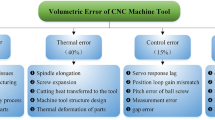Abstract
Tool condition monitoring is especially important in the modern machining process. As one of the basic parameters in the cutting process, cutting vibration is often adopted for the related research. Usually, to measure the vibration, the sensors are mounted on the material workpiece or the machine spindle, which limits the industrial application and brings the low accuracy for the significant physical distance between the sensors and the cutting process. In this article, an integrated wireless vibration sensing tool holder has been developed for tool condition monitoring in the milling process. A standard computer numerical control tool holder is simply modified to integrate sensor for vibration detecting, and related signal conditioning and wireless acquisition circuits are designed. The cutting test proves reliability and stability of the wireless vibration measuring system and shows the clear advantages compared with traditional wired sensors. Eventually, the continuous hidden Markov model (CHMM) has been adopted to diagnose tool wear condition based on vibration signals measured by the developed device. The results indicate that the proposed approach is efficient in tool wear monitoring.
Similar content being viewed by others
References
Byrne G, Dornfeld D, Inasaki I, Ketteler G, König W, Teti R (1995) Tool condition monitoring (TCM)—the status of research and industrial application. CIRP Ann Manuf Technol 44(2):541–567. https://doi.org/10.1016/S0007-8506(07)60503-4
Monnin J, Kuster F, Wegener K (2014) Optimal control for chatter mitigation in milling—part 1: modeling and control design. Control Eng Pract 24(1):156–166. https://doi.org/10.1016/j.conengprac.2013.11.010
Moradi H, Vossoughi G, Behzad M, Movahhedy MR (2015) Vibration absorber design to suppress regenerative chatter in nonlinear milling process: application for machining of cantilever plates. Appl Math Model 39(2):600–620. https://doi.org/10.1016/j.apm.2014.06.010
Suprock CA, Fussell BK, Hassan RZ, Jerard RB (2008) A low cost wireless tool tip vibration sensor for milling. ASME 2008 International manufacturing science and engineering conference 1:465–474
Totis G, Wirtz G, Sortino M, Veselovac D, Kuljanic E, Klocke F (2010) Development of a dynamometer for measuring individual cutting edge forces in face milling. Mech Syst Signal Process 24(6):1844–1857. https://doi.org/10.1016/j.ymssp.2010.02.010
Qin Y, Zhao Y, Li Y, Zhao Y, Wang P (2017) A novel dynamometer for monitoring milling process. Int J Adv Manuf Technol 92(5–8):2535–2543. https://doi.org/10.1007/s00170-017-0292-3
Ma L, Melkote SN, Morehouse JB, Castle JB, Fonda JW, Johnson MA (2012) Thin-film PVDF sensor based monitoring of cutting forces in peripheral end milling. J Dyn Syst Meas Control Trans ASME 134(5):51014
Ma L, Melkote SN, Castle JB (2014) PVDF sensor-based monitoring of milling torque. Int J Adv Manuf Technol 70(9):1603–1614. https://doi.org/10.1007/s00170-013-5410-2
Qin Y, Zhao Y, Li Y, Zhao Y, Wang P (2016) A high performance torque sensor for milling based on a piezoresistive MEMS strain gauge. Sensors 16(4):513. https://doi.org/10.3390/s16040513
Xie Z, Lu Y, Li J (2017) Development and testing of an integrated smart tool holder for four-component cutting force measurement. Mech Syst Signal Process 93:225–240. https://doi.org/10.1016/j.ymssp.2017.01.038
Chung TK, Yeh PC, Hao L, Lin CM, Tseng CY, Lo WT, Wang CM, Wang WC, CJ T, Tasi PY (2016) An attachable electromagnetic energy harvester driven wireless sensing system demonstrating milling-processes and cutter-wear/breakage-condition monitoring. Sensors 16(3):269. https://doi.org/10.3390/s16030269
Siddhpura A, Paurobally R (2013) A review of flank wear prediction methods for tool condition monitoring in a turning process. Int J Adv Manuf Technol 65(1–4):371–393. https://doi.org/10.1007/s00170-012-4177-1
Goyal D, Pabla BS (2016) The vibration monitoring methods and signal processing techniques for structural health monitoring: a review. Arch Comput Meth Eng 23(4):585–594
Sevilla-Camacho PY, Robles-Ocampo JB, Muñiz-Soria J, Lee-Orantes F (2015) Tool failure detection method for high-speed milling using vibration signal and reconfigurable bandpass digital filtering. Int J Adv Manuf Technol 81(5–8):1187–1194. https://doi.org/10.1007/s00170-015-7302-0
Hsieh W, Lu M, Chiou S (2011) Application of backpropagation neural network for spindle vibration-based tool wear monitoring in micro-milling. Int J Adv Manuf Technol 61:53–61
Fang N, Pai PS, Edwards N (2014) A method of using Hoelder exponents to monitor tool-edge wear in high-speed finish machining. Int J Adv Manuf Technol 72(9):1593–1601. https://doi.org/10.1007/s00170-014-5764-0
Wang M, Wang J (2012) CHMM for tool condition monitoring and remaining useful life prediction. Int J Adv Manuf Technol 59(5–8):463–471. https://doi.org/10.1007/s00170-011-3536-7
Zhu K, Wong YS, Hong GS (2009) Multi-category micro-milling tool wear monitoring with continuous hidden Markov models. Mech Syst Signal Process 23(2):547–560. https://doi.org/10.1016/j.ymssp.2008.04.010
Gao D, Liao Z, Lv Z, Lu Y (2015) Multi-scale statistical signal processing of cutting force in cutting tool condition monitoring. Int J Adv Manuf Technol 80(9–12):1–11
Liao Z, Gao D, Lu Y, Lv Z (2016) Multi-scale hybrid HMM for tool wear condition monitoring. Int J Adv Manuf Technol 84(9–12):2437–2448. https://doi.org/10.1007/s00170-015-7895-3
Park SS (2003) High frequency bandwidth cutting force measurements in milling using the spindle integrated force sensor system. Doctor of Philosophy, University of British Columbia, Vancouver
Shaw MC (2005) Metal cutting principles, 2nd edn. Oxford University Press, New York
Marwala T (2012) Data processing techniques for condition monitoring. In: Condition monitoring using computational intelligence methods: applications in mechanical and electrical systems. Springer London, London, pp 27–51. https://doi.org/10.1007/978-1-4471-2380-4_2
International Standard Organization (1989) Tool life testing in milling—part 2: end milling. ISO, London, p 8688-2
Rabiner L (1989) A tutorial on hidden Markov models and selected applications in speech recognition. Proc IEEE 77(2):257–286. https://doi.org/10.1109/5.18626
Acknowledgments
This work was supported by the National High Technology Research and Development Program of China (863 Program) under Grant no. 2013AA041107.
Author information
Authors and Affiliations
Corresponding author
Rights and permissions
About this article
Cite this article
Xie, Z., Li, J. & Lu, Y. An integrated wireless vibration sensing tool holder for milling tool condition monitoring. Int J Adv Manuf Technol 95, 2885–2896 (2018). https://doi.org/10.1007/s00170-017-1391-x
Received:
Accepted:
Published:
Issue Date:
DOI: https://doi.org/10.1007/s00170-017-1391-x




